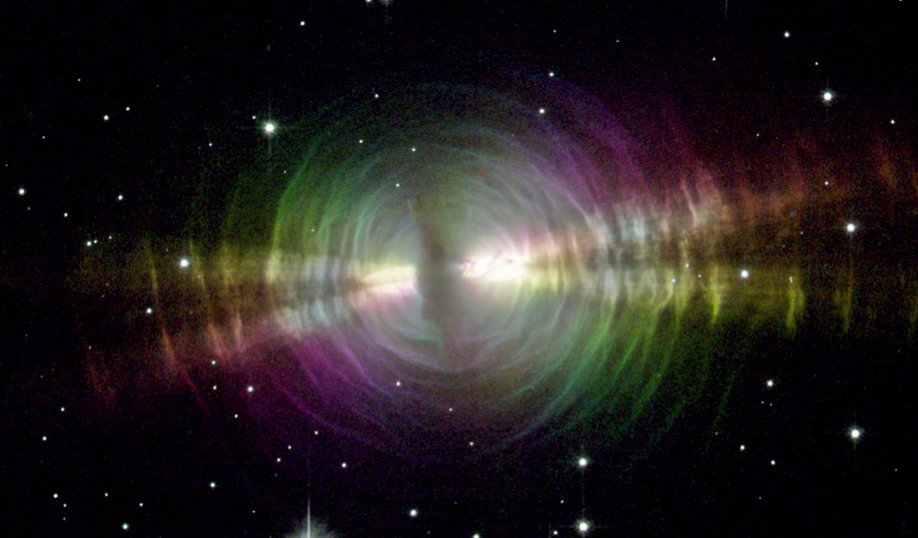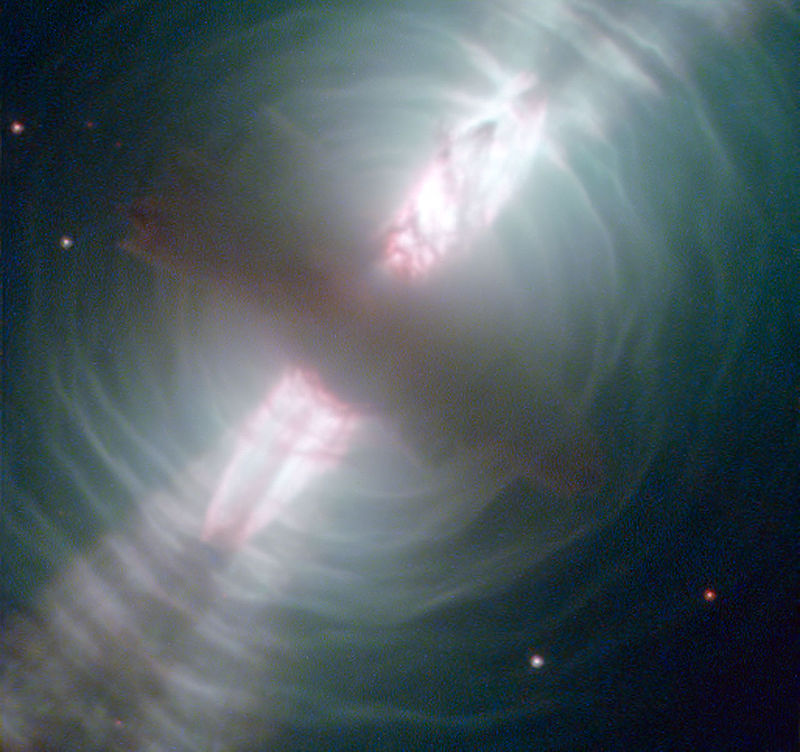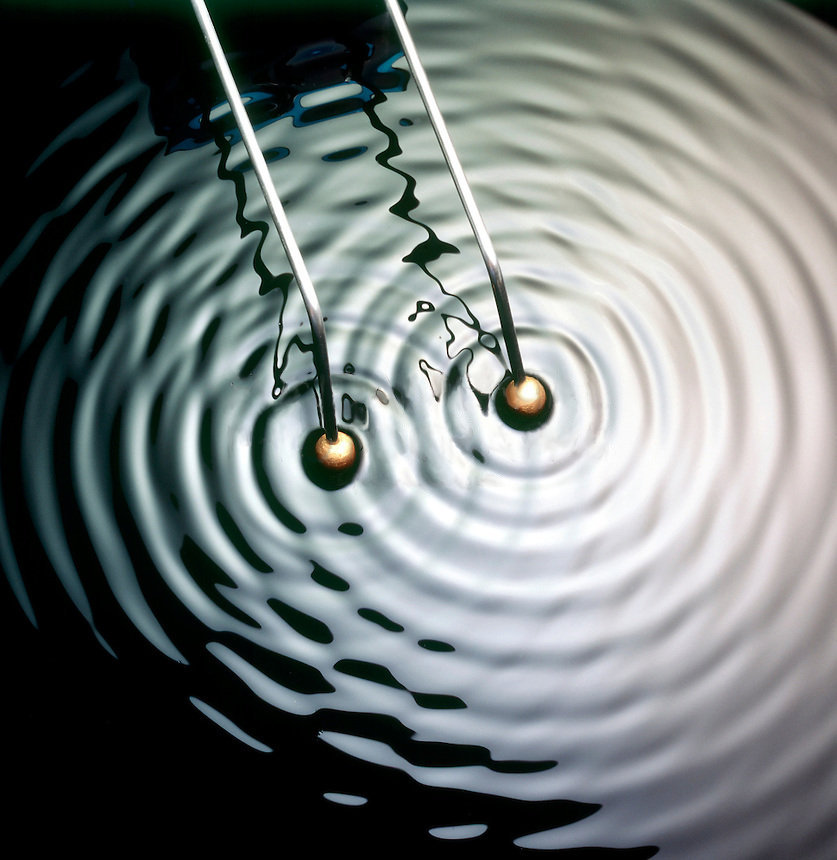© Charles ChandlerThe Egg Nebula appears to be a dusty plasma filament caught in the act of resolving into a "natural tokamak" (NT). (See Figure 1 and Figure 2.) As such, it makes an excellent case study. Its current condition corresponds to panels 3~5 in Figure 3. Note that we're looking at the Egg Nebula along the plane of rotation, instead of along the axis of rotation shown in Figure 3.Figure 1. Egg Nebula (CRL 2688). The false colors denote the polarization of the particles emitting the photons.
- The spherical ejecta are from the initial impact, as in panel 3 of Figure 3.
- The shock waves are somewhat irregular because there were two origins, instead of just one. (See Figure 4.) So what we're seeing is the ejecta from two separate collisions of filaments.
- The shock waves that were generated the earliest, and which are only made visible by the lighthouse beams in Figure 1, were considerably thinner than later waves. This is consistent with the collision of two opposing streams, where the density of the ejecta is a function of the degree of overlap between the streams.
- The thinner ejecta on the equatorial plane are to be expected, since there are two sources, and the one blocked the ejecta from the other.
- This thinness cannot be attributed just to proximity to the lighthouse beams, since there is no gradient in luminosity near them.
- This could also be explained by the presence of an accretion disc, but that's dismissed below.
- While the inflowing dusty plasma is primarily H2, the spherical ejecta are dominated by carbon and oxygen, meaning that the central star is fusing hydrogen into heavier elements.
- This is consistent with nuclear fusion in the counter-streaming implosions.
- Fusion by-products getting ejected above the gravitational escape velocity is not consistent with fusion due to gravitational loading deep inside a heavy star, since the overlying material that supplies the pressure always blocks the ejecta.
- The inflowing dusty plasma itself is visible on the near side (almost vertical in Figure 1, but at a 45° angle in Figure 2), which shows the ragged tail of the filament at the upper left, and organized arc structures (especially in other wavelengths1:L164) at the lower right.
- This is consistent with a filament spiraling toward the center, from the upper left to the lower right, before wrapping around behind the center (out of our sight).
- It is not consistent with an accretion disc, which would be curved on both limbs.
- The bipolar jets have just begun to erupt, and are in the process of merging together, but are still distinct streams. Thus this stage in the process is like panel 5 in Figure 3, since bipolar jets require annular explosions, but the charge streams haven't resolved into a single continuous toroid yet. Note that the jets themselves are just the fiery solid bodies, while the luminous channels defining the greatest extents of the "nebula" in Figure 1 are lighthouse beams.
- The beams have been explained as the consequence of a single light source being surrounded by an optically thick "cocoon", which has four holes in it (two on each side).1:L163,2:Fig5 But this doesn't explain:
- why the cocoon would have exactly two holes on each side, that happened to be perfectly opposite from the holes on the other side, and
- what kind of cocoon could resist the force of the bipolar jets.
- In the NT model, light generated within the jets is focused into beams due to the deflection of photons toward greater densities, which in this case is toward the axes of the jets.
- The polarization of particles evident in Figure 1 is consistent with Ampèrian magnetic fields generated by the bipolar jets. A positive charge stream generates a circular magnetic field, with the lines of force obeying one of the right-hand rules. So on one side, the magnetic polarity will be one way, and on the other, it's the opposite. The effect becomes more pronounced with distance from the center, which makes sense if the ejecta are still in the process of resolving into a collimated jet, due to the magnetic pinch effect. And since both of the bipolar jets are positively charged, they're both generating fields by the right hand rule, but they're traveling in opposite directions, so the polarity is flipped across the plane of rotation.
- The spherical ejecta are expanding at 20 km/s,3:26 and have travelled farther, while the smaller bipolar jets are expanding at ~300 km/s,1:L164,3 proving that the spherical ejecta started first, with the bipolar jets being proof of the development of a fundamentally different structure, which can only be annular.
Thus every aspect of the Egg Nebula is within the scope of the NT model, and there isn't any necessary component of the model that is not present.
Table 1. Exotic Star Properties
hyper
densepolar
jetsspins EM
rad.accr.
discradio
srcvari-
ablesolar
massesblack hole yes yes yes yes millions quasar yes yes yes yes yes blazar BL Lac yes neutron star yes yes pulsar yes yes yes yes yes magnetar yes yes white dwarf yes yes Wolf-Rayet yes
1. Sahai, R. et al. (1998): The Structure of the Prototype Bipolar Protoplanetary Nebula CRL 2688 (Egg Nebula): Broadband, Polarimetric, and H2 Line Imaging with NICMOS on the Hubble Space Telescope. The Astrophysical Journal Letters, 492 (2): L163-L167 ⇧ ⇧ ⇧
2. Sahai, R. et al. (1998): Imaging of the Egg Nebula (CRL 2688) with WFPC2/HST: A History of AGB/Post-AGB Giant Branch Mass Loss. Astrophysical Journal, 493: 301-311 ⇧
3. Balick, B. et al. (2011): The Illumination and Growth of CRL 2688: An Analysis of New & Archival HST Observations. ⇧ ⇧
4. Li, K. L. et al. (2012): A Luminous Be+White Dwarf Supersoft Source in the Wing of the SMC: MAXI J0158-744. arxiv, 1207.5023 ⇧
5. Nemmen, R. S. et al. (2012): A Universal Scaling for the Energetics of Relativistic Jets from Black Hole Systems. Science, 338 (6113): 1445-1448 ⇧













